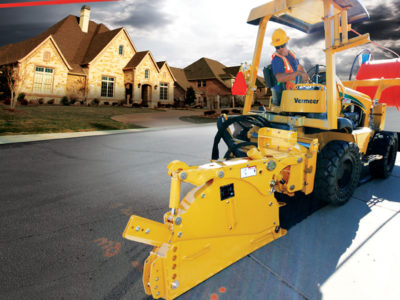There’s nothing small about planning for microtrenching jobs. While the actual trench might be narrow, there can be a lot to consider before you start a project. We break down those important considerations below.
First, let’s define exactly what microtrenching is. Microtrenching is a technique where a very narrow trench is cut into the pavement—usually close to the seam—where the road meets the curb. Once the line is laid, a grout compound is used to fill in the trench. The seam is then sealed, which protects the line while restoring the integrity of the road surface. This technique can be done by using a ride-on tractor (like the Vermeer RTX550 ride-on tractor).
These methods work well on fiberoptic or small conduit jobs because they can be more cost-effective and can take less time than other installation methods.
What do you need to know before you create that trench? Well, the essentials include the surface you’re trenching, vacuum excavation equipment, the width and depth of the cut and the backfill material. Let’s go through each one.
Know the surface (and underlayment)
The type of surface that you’ll be working with determines your approach. As you determine the surface, you should also make sure you know what’s underneath that surface.
“Knowing the surface helps you know what cutting wheel you will need to order with your microtrencher attachment,” explained Ed Savage, Vermeer product manager.
Road surfaces range from asphalt to concrete, which will determine the cutting wheel design that will maximize productivity. Either an MTR12 or MTR16 microtrenching attachment can be used for these applications, depending on the required trench depth.
Choose the right vacuum excavation equipment
After you know what type of material you’re cutting, you have to determine what you’re going to do with the dry spoil. A connected vacuum system cleanly removes and contains the spoil, allowing you to take it away from the worksite while you’re microtrenching. Usually, this is connected through a hose from your microtrenching attachment to the vac.
When it comes to vac systems, you have several options. There are trailer vacs and truck vacs, but they also include a range of models and sizes.
“To make an informed decision, you have to ask yourself how big of a vac you would need for the majority of your projects and how often you want to have to go dump it,” said Savage. “That will help you choose which vac equipment to go with.”
Know the width and depth of the cut
With your equipment chosen, it’s time to think more about the actual trench. How wide and how deep does it need to be? For microtrenching, the actual trench is fairly small. The trench generally ranges from .75-inches to 2.25-inches (1.9-cm to 5.7-cm) wide and up to 16-inches (40.6-cm) deep, which is typically above existing utilities.
Knowing the width and depth of the trench can help you prepare for the project and understand what type of production to expect.
“You also should know how many feet of trench you want to cut per day,” explained Savage. “That can help you estimate how long the project will take and have the right vac system in place.”
Rocksaw attachments also play a key role. Knowing the width and depth helps you decide what attachment you should use. Should you use the microtrencher MTR16 with a maximum trench-cutting depth of 16 inches (40.6 cm) and trench width of 2.25 inches (5.7 cm)? Or is the rockwheel RW526 with a maximum cutting depth of 26 inches (66 cm) and a cutting width of 4 inches to 6 inches (10.2 cm to 15.2 cm) the better option? Your planning is only as good as the information and equipment you have.
Prepare your backfill material
After the trench is cut and the product is placed in the trench, all that’s left to do is backfill the trench. This requires backfill material, which can be a grout, epoxy or a sealer approved by a local governing body.
Again, this is another important piece of microtrenching projects and requires some preparation to have a plan in place for backfill material. Knowing the width, depth and length of the trench can help you estimate how much backfill material you’ll need to complete the job.
As you start to explore more about the benefits of microtrenching, be sure to visit vermeer.com or contact your local dealer.
Vermeer Corporation reserves the right to make changes in engineering, design and specifications; add improvements; or discontinue manufacturing at any time without notice or obligation. Equipment shown is for illustrative purposes only and may display optional accessories or components specific to their global region.
Please contact your local Vermeer dealer for more information on machine specifications.
Vermeer and the Vermeer logo are trademarks of Vermeer Manufacturing Company in the U.S. and/or other countries.
© 2021 Vermeer Corporation. All Rights Reserved.
